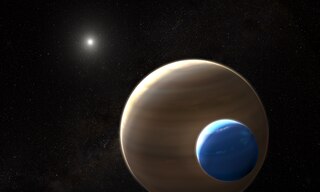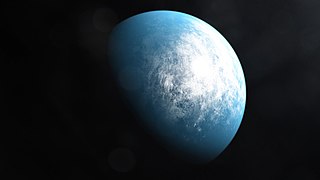Related Research Articles

An exomoon or extrasolar moon is a natural satellite that orbits an exoplanet or other non-stellar extrasolar body.

WASP-12b is a hot Jupiter orbiting the star WASP-12, discovered in April of 2008, by the SuperWASP planetary transit survey. The planet takes only a little over one Earth day to orbit its star, in contrast to about 365.25 days for the Earth to orbit the Sun. Its distance from the star is only the Earth's distance from the Sun, with an eccentricity the same as Jupiter's. Consequently, it has one of the lowest densities for exoplanets. On December 3, 2013, scientists working with the Hubble Space Telescope (HST) reported detecting water in the atmosphere of the exoplanet. In July 2014, NASA announced finding very dry atmospheres on three exoplanets orbiting sun-like stars.

Transiting Exoplanet Survey Satellite is a space telescope for NASA's Explorer program, designed to search for exoplanets using the transit method in an area 400 times larger than that covered by the Kepler mission. It was launched on 18 April 2018, atop a Falcon 9 launch vehicle and was placed into a highly elliptical 13.70-day orbit around the Earth. The first light image from TESS was taken on 7 August 2018, and released publicly on 17 September 2018.

CoRoT-7b is an exoplanet orbiting the star CoRoT-7 in the constellation of Monoceros, 489 light-years from Earth. It was first detected photometrically by the French-led CoRoT mission and reported in February 2009. Until the announcement of Kepler-10b in January 2011, it was the smallest exoplanet to have its diameter measured, at 1.58 times that of the Earth and the first potential extrasolar terrestrial planet to be found. The exoplanet has a very short orbital period, revolving around its host star in about 20 hours.

An exoplanet is a planet located outside the Solar System. The first evidence of an exoplanet was noted as early as 1917, but was not recognized as such until 2016; no planet discovery has yet come from that evidence. What turned out to be the first detection of an exoplanet was published among a list of possible candidates in 1988, though not confirmed until 2003. The first confirmed detection came in 1992, with the discovery of terrestrial-mass planets orbiting the pulsar PSR B1257+12. The first confirmation of an exoplanet orbiting a main-sequence star was made in 1995, when a giant planet was found in a four-day orbit around the nearby star 51 Pegasi. Some exoplanets have been imaged directly by telescopes, but the vast majority have been detected through indirect methods, such as the transit method and the radial-velocity method. As of 1 April 2024, there are 5,653 confirmed exoplanets in 4,161 planetary systems, with 896 systems having more than one planet. This is a list of the most notable discoveries.

Kepler-90, also designated 2MASS J18574403+4918185, is a F-type star located about 2,790 light-years (855 pc) from Earth in the constellation of Draco. It is notable for possessing a planetary system that has the same number of observed planets as the Solar System.

K2-288Bb is a super-Earth or mini-Neptune exoplanet orbiting in the habitable zone of K2-288B, a low-mass M-dwarf star in a binary star system in the constellation of Taurus about 226 light-years from Earth. It was discovered by citizen scientists while analysing data from the Kepler spacecraft's K2 mission, and was announced on 7 January 2019. K2-288 is the third transiting planet system identified by the Exoplanet Explorers program, after the six planets of K2-138 and the three planets of K2-233.
TOI-700 is a red dwarf 101.4 light-years away from Earth located in the Dorado constellation that hosts TOI-700 d, the first Earth-sized exoplanet in the habitable zone discovered by the Transiting Exoplanet Survey Satellite (TESS).

TOI-700 d is a near-Earth-sized exoplanet, likely rocky, orbiting within the habitable zone of the red dwarf TOI-700, the outermost planet within the system. It is located roughly 101.4 light-years (31.1 pc) away from Earth in the constellation of Dorado. The exoplanet is the first Earth-sized exoplanet in the habitable zone discovered by the Transiting Exoplanet Survey Satellite (TESS).
K2-66b is a confirmed mega-Earth orbiting the subgiant K2-66, about 520 parsecs (1,700 ly) from Earth in the direction of Aquarius. It is an extremely hot and dense planet heavier than Neptune, but with only about half its radius.
HIP 67522 b is a hot Jupiter exoplanet orbiting the G-type star HIP 67522, located approximately 415 light-years from Earth in the constellation Centaurus, discovered using the Transiting Exoplanet Survey Satellite (TESS). It is currently the youngest hot Jupiter discovered, at an age of only 17 million years; it is also one of the youngest transiting planets of any type, and one of only four others less than 100 million years old to have the angle between its orbit and its host star's rotation measured, at 5.8+2.8
−5.7 degrees. This planet, in turn, may help in knowing how other hot Jupiters form.
TESS Hunt for Young and Maturing Exoplanets (THYME) is an exoplanet search project. The researchers of the THYME collaboration are mainly from the United States and search for young exoplanets using data from the Transiting Exoplanet Survey Satellite (TESS). The new discoveries should help to understand the early evolution of exoplanets. As of March 2023 the collaboration produced 9 papers announcing the discovery of exoplanets.

TOI-2180 b is a giant exoplanet orbiting the G-type star TOI-2180, also known as HD 238894. It was discovered with the help of the Transiting Exoplanet Survey Satellite and is currently the exoplanet with the longest orbital period TESS was able to uncover. TOI-2180 b orbits its host star every 260.16 days.
HD 63433 is a G-type main sequence star located 73 light-years from Earth in the zodiacal constellation Gemini, visually close to the star Pollux. It is classified as a Sun-like star, having a mass 99% similar and a size 91% similar to that of the Sun. However, it is a much younger star, less than one tenth as old with an age of about 400 million years. With an apparent magnitude of 6.9, it is not visible to the naked eye, but can be seen with a small telescope. Based on its kinematic, rotational and lithium abundance properties, it is part of the Ursa Major Moving Group. There are three exoplanets orbiting it, one is classified as an Earth-sized planet, while the two others are mini-Neptunes.
HD 63433 c is a mini-Neptune exoplanet orbiting the Sun-like star HD 63433. It is the outermost planet in its planetary system, being located 0.1448 astronomical units (21,660,000 km) from its star, and completing one orbit every 21 days. Despite being the outermost planet in the system, it is still located close to its star, meaning that its temperature is hot, being estimated between 267 and 406 °C. HD 63433 c is about 2.7 times larger than Earth and 15.5 times more massive, but still smaller and less massive than Neptune. In 2022, a study showed that its atmosphere, made up of hydrogen, is being evaporated by the strong radiation from its star, causing it to slowly turn into a super-Earth planet.
References
- 1 2 3 4 5 6 7 8 9 10 11 12 13 14 15 Capistrant, Benjamin K.; Soares-Furtado, Melinda; Vanderburg, Andrew; Jankowski, Alyssa; Mann, Andrew W.; Ross, Gabrielle; Srdoc, Gregor; Hinkel, Natalie R.; Becker, Juliette; Magliano, Christian; Limbach, Mary Anne; Stephan, Alexander P.; Nine, Andrew C.; Tofflemire, Benjamin M.; Kraus, Adam L. (January 10, 2024). "TESS Hunt for Young and Maturing Exoplanets (THYME). XI. An Earth-sized Planet Orbiting a Nearby, Solar-like Host in the 400 Myr Ursa Major Moving Group". The Astronomical Journal. 167 (2): 54. arXiv: 2401.04785 . Bibcode:2024AJ....167...54C. doi: 10.3847/1538-3881/ad1039 . ISSN 1538-3881.
- ↑ Martin, Pierre-Yves (2024). "Planet HD 63433 b". exoplanet.eu. Retrieved 2024-01-12.
- 1 2 3 de Lazaro, Enrico (January 15, 2023). "Earth-Sized Exoplanet Found Orbiting HD 63433". SciNews. Retrieved January 16, 2023.
- 1 2 3 4 5 6 Robert, Lea (January 12, 2024). "Newfound Earth-size exoplanet has a scorching-hot lava side". Space. Archived from the original on January 12, 2024. Retrieved January 12, 2024.
- 1 2 3 4 5 6 7 8 9 Gohd, Chelsea (January 10, 2024). "Discovery Alert: Earth-sized Planet Has a 'Lava Hemisphere'". science.nasa.gov. Archived from the original on January 15, 2024. Retrieved January 15, 2024.
- ↑ Thomson, Jess (January 12, 2024). "Hellish World With 2,294 F 'Lava Hemisphere' Discovered by NASA". Newsweek. Retrieved January 23, 2024.
- 1 2 3 "'Extra hot and young' Earth-sized exoplanet with a 'lava hemisphere' discovered". wionews.com. January 17, 2024.
- ↑ Gough, Evan (January 12, 2024). "Half of this Exoplanet is Covered in Lava". Universe Today.
- 1 2 Staff, Buzz (16 January 2024). "NASA Telescope Discovers Half-Lava Exoplanet Of Same Size As Earth". News18. Retrieved January 16, 2024.
- 1 2 Whitwam, Ryan (January 15, 2024). "Astronomers Discover Earth-Sized Planet That's Half Lava". ExtremeTech. Retrieved January 17, 2024.
- 1 2 Szondy, David (January 11, 2024). "Tidally locked exo-Earth has a lava ocean hemisphere". New Atlas. Archived from the original on January 16, 2024. Retrieved January 14, 2024.
- ↑ Maruccia, Alfonso (January 16, 2024). "NASA discovers new exoplanet with a "lava hemisphere" in a distant star system". Techspot. Retrieved January 17, 2024.
- 1 2 3 Mann, Andrew W.; Johnson, Marshall C.; Vanderburg, Andrew; Kraus, Adam L.; Rizzuto, Aaron C.; Wood, Mackenna L.; Bush, Jonathan L.; Rockcliffe, Keighley; Newton, Elisabeth R.; Latham, David W.; Mamajek, Eric E.; Zhou, George; Quinn, Samuel N.; Thao, Pa Chia; Benatti, Serena (2020-10-01). "TESS Hunt for Young and Maturing Exoplanets (THYME). III. A Two-planet System in the 400 Myr Ursa Major Group". The Astronomical Journal. 160 (4): 179. arXiv: 2005.00047 . Bibcode:2020AJ....160..179M. doi: 10.3847/1538-3881/abae64 . ISSN 0004-6256.
- ↑ "⬤ Exoplanet HD 63433 d". Stellar Catalog. Retrieved 2024-01-16.
- ↑ Siegel-Itzkovich, Judy (January 14, 2024). "Earth-sized exoplanet discovered in 'our solar backyard' by international team". The Jerusalem Post. Archived from the original on January 20, 2024. Retrieved January 20, 2024.